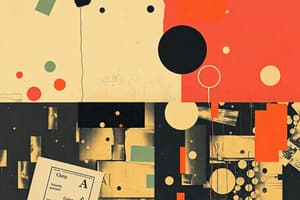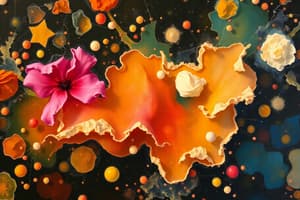Podcast
Questions and Answers
Which of the following is NOT a physical property of matter?
Which of the following is NOT a physical property of matter?
- Melting point
- Reactivity with acid (correct)
- Color
- Density
What is the state change process where a solid directly turns into a gas?
What is the state change process where a solid directly turns into a gas?
- Freezing
- Sublimation (correct)
- Deposition
- Condensation
Which of the following is an example of a heterogeneous mixture?
Which of the following is an example of a heterogeneous mixture?
- Sugar dissolved in water
- Saltwater
- Sand and water (correct)
- Air
Which scientist proposed the first atomic theory, stating that atoms are tiny, solid spheres?
Which scientist proposed the first atomic theory, stating that atoms are tiny, solid spheres?
Which of the following methods would be most effective in separating a mixture of iron filings and sand?
Which of the following methods would be most effective in separating a mixture of iron filings and sand?
What is the primary reason diffusion occurs faster in gases than in liquids?
What is the primary reason diffusion occurs faster in gases than in liquids?
Which of these examples represents a chemical change?
Which of these examples represents a chemical change?
Which of these is NOT a valid method for separating a mixture?
Which of these is NOT a valid method for separating a mixture?
Which of these properties would be considered a chemical property?
Which of these properties would be considered a chemical property?
Which of the following is NOT an example of a physical change?
Which of the following is NOT an example of a physical change?
According to the Kinetic Molecular Theory, what happens to the particles of a substance when the temperature is increased?
According to the Kinetic Molecular Theory, what happens to the particles of a substance when the temperature is increased?
Which of the following is a valid method for separating a mixture of salt and water?
Which of the following is a valid method for separating a mixture of salt and water?
Which scientist is credited with proposing the "plum pudding" model of the atom, where electrons are embedded within a positively charged sphere?
Which scientist is credited with proposing the "plum pudding" model of the atom, where electrons are embedded within a positively charged sphere?
Which of the following is an example of a homogeneous mixture (solution)?
Which of the following is an example of a homogeneous mixture (solution)?
What is the process of separating mixtures based on the different boiling points of the components called?
What is the process of separating mixtures based on the different boiling points of the components called?
Which of these is an example of a chemical change, based on the clues provided in the text?
Which of these is an example of a chemical change, based on the clues provided in the text?
Which of these scenarios is NOT a change of state?
Which of these scenarios is NOT a change of state?
Which scientific model proposed that electrons move in fixed orbits around the nucleus, like planets orbiting the sun?
Which scientific model proposed that electrons move in fixed orbits around the nucleus, like planets orbiting the sun?
Which of the following is a physical change?
Which of the following is a physical change?
According to the Kinetic Molecular Theory, what happens to the average kinetic energy of particles when the temperature increases?
According to the Kinetic Molecular Theory, what happens to the average kinetic energy of particles when the temperature increases?
Which of the following is NOT a valid method for separating a mixture?
Which of the following is NOT a valid method for separating a mixture?
Which scientist is credited with conducting the gold foil experiment that led to the discovery of the atomic nucleus?
Which scientist is credited with conducting the gold foil experiment that led to the discovery of the atomic nucleus?
Which of the following properties would be considered a chemical property?
Which of the following properties would be considered a chemical property?
Which of the following is a homogeneous mixture (solution)?
Which of the following is a homogeneous mixture (solution)?
Flashcards
Pure Substances
Pure Substances
Made of only one type of particle; can be elements or compounds.
Mixtures
Mixtures
Combinations of two or more substances that are physically mixed but not chemically combined.
Homogeneous Mixtures
Homogeneous Mixtures
Mixtures that have a uniform composition throughout, like solutions.
Heterogeneous Mixtures
Heterogeneous Mixtures
Signup and view all the flashcards
Physical Properties
Physical Properties
Signup and view all the flashcards
Chemical Changes
Chemical Changes
Signup and view all the flashcards
Kinetic Molecular Theory (KMT)
Kinetic Molecular Theory (KMT)
Signup and view all the flashcards
Distillation
Distillation
Signup and view all the flashcards
Physical Changes
Physical Changes
Signup and view all the flashcards
Chemical Properties
Chemical Properties
Signup and view all the flashcards
Melting
Melting
Signup and view all the flashcards
Evaporation
Evaporation
Signup and view all the flashcards
Filtration
Filtration
Signup and view all the flashcards
Diffusion
Diffusion
Signup and view all the flashcards
Sublimation
Sublimation
Signup and view all the flashcards
Deposition
Deposition
Signup and view all the flashcards
Changes of States of Matter
Changes of States of Matter
Signup and view all the flashcards
Freezing
Freezing
Signup and view all the flashcards
Condensation
Condensation
Signup and view all the flashcards
Magnetism in Separation
Magnetism in Separation
Signup and view all the flashcards
Evaporation vs. Condensation
Evaporation vs. Condensation
Signup and view all the flashcards
Kinetic Molecular Theory (KMT) - Temperature
Kinetic Molecular Theory (KMT) - Temperature
Signup and view all the flashcards
Physical Change Examples
Physical Change Examples
Signup and view all the flashcards
Chemical Changes Clues
Chemical Changes Clues
Signup and view all the flashcards
Study Notes
Pure Substances and Mixtures
- Pure substances are composed of only one type of particle.
- Elements (e.g., oxygen, O₂) and compounds (e.g., water, H₂O) are pure substances.
- Mixtures are made of two or more substances physically combined.
- Homogeneous mixtures (solutions) appear uniform throughout (e.g., saltwater).
- Heterogeneous mixtures have visible different parts (e.g., salad).
Physical and Chemical Properties
- Physical properties can be observed without changing the substance (e.g., color, density, melting point).
- Chemical properties describe how a substance reacts with other substances (e.g., flammability, reactivity with acid).
Physical vs. Chemical Changes
- Physical changes do not create new substances. They alter form or state (e.g., melting ice, cutting paper).
- Chemical changes create new substances with different properties (e.g., burning wood, rusting iron).
- Clues include color change, gas production, or temperature change.
Kinetic Molecular Theory (KMT)
- All matter is composed of tiny particles in constant motion.
- Particles are always in motion.
- Higher temperatures lead to faster particle movement.
- Solids, liquids, and gases have different particle arrangements.
Changes of States of Matter
- Melting: Solid to liquid (heat added).
- Freezing: Liquid to solid (heat removed).
- Evaporation: Liquid to gas (heat added).
- Condensation: Gas to liquid (heat removed).
- Sublimation: Solid directly to gas (e.g., dry ice).
- Deposition: Gas directly to solid (e.g., frost).
Separating Mixtures
- Filtration separates solids from liquids (e.g., coffee filter).
- Evaporation removes a liquid to leave a solid behind (e.g., salt from seawater).
- Distillation separates liquids based on boiling points.
- Magnetism separates magnetic materials (e.g., iron filings from sand).
Diffusion
- Particles move from high concentration to low concentration.
- Diffusion is faster in gases than in liquids.
- Example: Smelling perfume from across the room.
History of an Atom
- Democritus (400 BCE) proposed the idea of indivisible particles ("atomos").
- John Dalton (1803) proposed a theory of atoms as tiny, solid spheres.
- J.J. Thomson (1897) discovered the electron, leading to the plum pudding model, using the cathode ray tube.
- Ernest Rutherford (1911) discovered the nucleus through the gold foil experiment.
- Niels Bohr (1913) proposed electrons orbit the nucleus in fixed paths.
- The modern (quantum mechanical) model describes electrons as existing in electron clouds.
Atomic Theory and Subatomic Particles
- Atomic theory states all matter is made of atoms.
- Atoms are composed of protons, neutrons, and electrons.
- Protons (+), in the nucleus, have a positive charge.
- Neutrons (0), in the nucleus, have no charge.
- Electrons (-), in electron clouds, have a negative charge.
- Atomic number equals the number of protons.
- Mass number equals protons + neutrons.
Studying That Suits You
Use AI to generate personalized quizzes and flashcards to suit your learning preferences.




